Composers of the Medieval Period
Music of the Medieval Period
Monophonic Chant
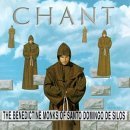
Chant (CD)
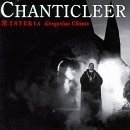
Mysteria: Gregorian Chants (CD)
Early Christians were influenced by the Jewish cantorial singing
heard in the synagogues. Early christians attended synagogue
services followed by a reenactment of the last supper, known as
"agape" or feast of love. At the feast of love, a cantor would
perform psalms and intone prayers. Often psalm settings would be
performed first by the cantor and then by the congregation. These
melodies grew in number and variety as the christian church spread
geographically.
From the seventh to the ninth century A.D. all of non-Roman
chant practices except the Ambrosian in Milan were gradually
absorbed into a single practice regulated by the Roman Catholic
Church. Regulation and standardization changed the performance of
chant from a passionate outpouring of religious fervor to a
disciplined and orderly expression of piety. The codified body of
Roman chant that resulted came to be known as plainsong (cantus
planus) or Gregorian chant, after Pope Gregory the Great who
reigned from 590 to 604 A.D. .Attempts to preserve existing chant
in notated form began in the 9th century by adding markings to the
text to remind singers of melodies they had already learned. The
acute ( / ), grave ( \ ), and circumflex ( /\ ) accents were
written above the text of an existing chant in patterns that showed
the general shape of the melody. Toward the end of the 10th
century, a horizontal line was introduced to represent the location
of the pitch F. Later a second line was added to indicate the pitch
C. Sometimes various colors were used in the manuscript to help
readers discriminate among the staff lines. Guido d’Arezzo in the 11th
century codified a practice for notating Gregorian Chant melodies
which is still in use today.
Gregorian chant is monophonic, unaccompanied, and sung in free and placid rhythms that often follow the inflections of the text. Most Gregorian melodies exhibit a balance between syllabic and neumatic (several notes sung on one syllable) writing with melismas (many notes sung on one syllable) occuring rarely if at all. Conjunct motion prevails in these melodies and traditional performance involves almost no vibrato. Gregorian chants were written with a limited melodic range, probably to prevent the voice from sounding strained. Traditional chants are sung in Latin and notated in neumatic notation. Admired for its simplicity and subtle expression, this body of chant influenced most of the sacred music of Western Europe until the sixteenth century.
Secular Music
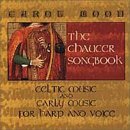
The Chaucer Songbook (CD)
Although the Catholic Church is enormously
important in the history of medieval music, it should not be
assumed that secular music had no place in medieval Europe. Secular
music of the medieval period was the domain of minstrels,
minnesingers, troubadours and trouvères. These traveling
performers juggled, danced, sang, and played musical instruments
throughout medieval Europe. Secular music of the time was
monophonic, syllabic with short melismas, and unaccompanied with
instruments used only for intros, postludes, and occasionally
heterophony. Secular songs often described courtly love, the love
of a knight for a shepherdess (the pastourelle form), religious
crusades, or other adventures. The contributions of medieval
secular music include many structural devices like poetic forms
(the Formes Fixe) and the melodic refrain.
Polyphonic Chant
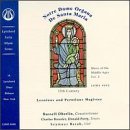
Leonin and Perotin (CD)
The practice of doubling a chant at the fourth, fifth, or octave
became common in the late 9th century. The voice singing the chant
was called the vox principalis and the other voice was called the
vox organalis. The term "organum" was used to describe this early
polyphony. As the practice of organum evolved, more or less
free-moving parts were added above and below the traditional church
melody. Organum reached its maturity in the 2-voice and 3-voice
works of Leonin (late
12th century) and Perotin (late 12th century to
early 13th century). These men worked at the Notre Dame cathedral
in Paris and their work is known as the Notre Dame School of
Organum.
In two and three-voice organa by Leonin we often find sections
(clausulae) in discant style (syllabic, note-against-note harmony).
Perotin and the next
generation of composers created many discant clausulae as
substitutes for those of Leonin and other early composers. These
"substitute" clausulae were popular among composers who often added
Latin texts, appropriate to the sentiment of the cantus, to the
upper voices. The voice assigned to sing the new text was called
the "motetus" which comes from the French word "mot" meaning
"word". Eventually these substitute clausulae became independent
works much in the same way as the sequence was emancipated from its
role as an appendage to the alleluia and the word "motet" came to
signify the composition as a whole. The motet was the dominant
polyphonic form of the 13th century. The work of French composers
was widely imitated all over Europe.
The Canon was also an important form. Sumer is icumen in, arguably the most well-known work of the period, is an example of a Rota (canon), which dates from about 1240 and is of English origin. Below the four-part canon, two tenors sing a pes ("foot" i.e. a repeated bass motive) with interchange of voices. The music emphasizes major tonality rather than one of the church modes, with a full sounding texture, harmonic unity, and use of thirds and sixths as consonances.
Ars Nova (the new art)
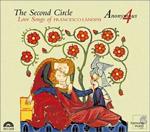
Landini Love Songs
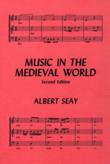
Music in the
Medieval World
The Ars Nova, a period named for a famous treatise
written by Philippe de
Vitry c. 1316, began in the 14th century and was characterized
by an emphasis on polyphony in popular song and more variety in
metrical structures including duple and compound duple. As the
century progressed, notation practices were refined and the music
became more rhythmically complex and syncopated. Guillaume de Machaut and Francesco Landini are the
most widely-known composers of the Ars Nova. Machaut worked in France and
composed mostly three-part ballades and rondeaux in addition to the
monophonic lais and virelais forms. Landini worked in Italy and
composed many works in a form known as the ballata. The ballata was
similar to the French virelais. In England, composers like John Dunstable were
establishing their own style with a heavier use of major thirds as
consonant intervals. The politics of the 15th century gave English
composers opportunities to influence their continental colleagues.
Dufay and Binchois emerged as leaders
in France of a new school of composition known as the Burgundian
school. The Dukes of Burgundy and other nobles during this time
actively recruited the finest musicians from all over Europe to
compose and perform in their chapels. As a result, the styles of Dunstable, Dufay, and Binchois show cosmopolitan
influences. One of the more popular forms of the early 15th century
was the Chanson, a secular song with French text, but masses,
magnificats, and motets were also composed in abundance. The
intense creative activity of the mid to late 15th century resulted
in a complex choral style of four equal voices. This style became
mature in the Renaissance works of Obrecht and Josquin des Prez.